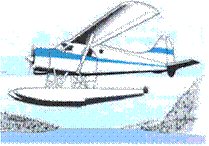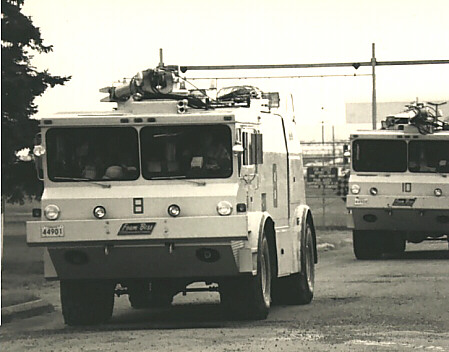Shoulder Harnesses, Seats, and Lap Belts

Shortly after takeoff, the Pratt & Whitney engine quit. The Beaver pilot manoeuvred around higher terrain and was heading back to the lake when the aircraft stalled at low altitude and crashed into the water. The accident was deemed survivable by the TSB investigators (A93Q0145). However, due to a combination of several factors, only one of the six people on board survived.
Mining crews stationed at an isolated lake were going to a nearby town for a crew change. The lake is surrounded by 700 to 1000 ft. mountains. The takeoff/landing distance is about 2 km. in an east west direction. Conditions on this day were conducive to serious carb icing: the temperature was 13° and the dew point, 12°. Winds were from the south southwest at 10 to 15 kt.
On the second flight, the pilot loaded five passengers on board. He taxied to the middle of the lake and began his takeoff in a northeasterly downwind direction. Once airborne, he climbed southward through a valley. At that point, mountains on both sides prevented a 180° turn back to the lake when the engine quit. He had not stacked the odds in his favour with a mid lake downwind takeoff.
He had, however, completed the Engine Failure Check, including Carb Heat ON. But he didn't have enough altitude to both manoeuvre around the mountain and stretch his glide to reach the water safely. The aircraft stalled and struck the water in a 60° nose down, left wing low attitude.
The front and centre seat belts were anchored to the seat frames, not the airframe; thus, when the pilot's and copilot's seat-attachment points failed, as did the centre-seat attachments, the two front seat occupants were thrown into the instrument panel. The pilot suffered incapacitating head injuries and drowned. The right-seat occupant's injuries were fatal.
The centre-seat passengers were thrown forward against the metal backs of the front seats. Like the pilot, the left centre passenger suffered incapacitating head injuries and drowned. The right centre passenger died at impact.
The two rear seat passengers, whose seat belts were anchored to the airframe, remained in their seats and survived. However, one died three hours later from abdominal injuries.
The limited deformation of the aircraft fuselage made the accident survivable. Impact forces did not exceed the limits of human tolerance.
Investigators also reasonably concluded that if all seat belts had been anchored to the airframe, and if shoulder harnesses had been installed and used, more of the aircraft occupants would have survived.
Originally Published: 2/1997
Original Article: Shoulder Harnesses, Seats and Lap Belts
You're on Fire! — OK. We'll Just Taxi to the Ramp

Need one of these?
The Piper PA-31 was on a 20-mile final when the turbocharger on the right engine failed. The pilot continued inbound for an uneventful landing at the Sioux Lookout airport.
As the aircraft slowed to taxi speed on the runway, the alert Flight Service Specialist saw large amounts of smoke coming from the right engine. He immediately alerted the pilot. Undaunted, the pilot acknowledged and advised that he would continue to taxi and park the aircraft. (Access to the parking ramp at Sioux Lookout is via a steep up-hill taxiway. It requires significant engine power to climb up).
By the time the aircraft was parked and the pilot was shutting down, flames were visible beneath the engine nacelle and lower wing. The specialist once again alerted the pilot. But by now, available fire extinguishers could not bring the fire under control.
Firefighters from town were called and, after the expected delay involved in their highspeed drive from town, finally put the fire out.
As expected, the fire source was traced to oil leaking from the failed turbocharger. It's hard to believe, but, despite how long the fire was evident, the insulation blanket around the turbocharger actually contained the fire and prevented major damage to the aircraft. A quick parts change, and the aircraft was back in the air the next day.
However, one has to wonder at the thought processes of a pilot who is safely on the ground, and who continues to run the engines in the face of powerful evidence that he is about to be turned to ashes.
Originally Published: 1/1997
Original Article: You're on Fire! - OK. We'll Just Taxi to the Ramp
Little Patience on a Not-so-good Day!
On final approach to the runway, the Piper Malibu struck a snow bank 125 feet short of the threshold. The impact and the following hard landing caused substantial damage to the wings and the landing gear. The pilot taxiied to the hangar where he inspected the damage.
No doubt angry with himself, frustrated and impatient, he decided to taxi the aircraft into the hangar, but did not appreciate that the damaged aircraft now sat on the ground in a tail-high, nose-low attitude. As he entered the hanger, the aircraft’s vertical fin hit the top of the door and the propeller slammed into a steel tow bar.
Originally Published: ASL 4-1996
Original Article: Just Briefly - Little Patience on a Not-so-good Day!
How's Your Passenger Briefing?
The Piper Navajo was only a few minutes en route when the overwing Emergency Exit panel opened and departed the aircraft. Luckily, its departure did no other damage to the airframe.
The pilot immediately initiated a return to base and landed safely. It turned out that a curious passenger had removed the plastic cover over the exit handle, and then operated the Emergency Exit release handle.
The pilot and five of the six passengers were no worse for wear. The sixth passenger complained of frosbite — perhaps that was our curious friend.
Passenger safety briefings need to do more than just point out where the exits are. Some do's and don'ts need to be included. Obviously, common sense isn't common.
Originally Published: 1/1997
Original Article: How's Your Passenger Briefing?




























